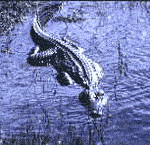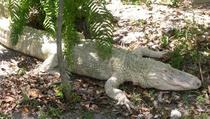American alligator
 What's the difference between an Alligator and a Crocodile? Well, one has to keep in mind, that Alligators are Crocodiles too. But they form a separate group within the order Crocodylia, which differs from the rest of the Crocodiles. Nowadays about 30 Crocodile species are known, just two of them are "real" Alligators - the members of the genus Alligator: the Mississippi alligator (Alligator mississippiensis) and the Chinese alligator (Alligator sinensis). The Caymans are seen as Alligators in the broader sense too. Together with the two "real" Alligators the Caymans form the family Alligatoridae. Alligators are an ancient group of Crocodiles. In the course of millions of years they changed less in many markings than the other Crocodiles. Their metabolism and their whole life is slower than in "modern" Crocodiles. They grow less rapidly and need less food. Alligators reach a maximum age of 75 years, which means that they can get about twice as old as "modern" Crocodiles. It is assumed that Alligators have been distributed worldwide in former times, but then have been replaced by "modern" Crocodiles.
What's the difference between an Alligator and a Crocodile? Well, one has to keep in mind, that Alligators are Crocodiles too. But they form a separate group within the order Crocodylia, which differs from the rest of the Crocodiles. Nowadays about 30 Crocodile species are known, just two of them are "real" Alligators - the members of the genus Alligator: the Mississippi alligator (Alligator mississippiensis) and the Chinese alligator (Alligator sinensis). The Caymans are seen as Alligators in the broader sense too. Together with the two "real" Alligators the Caymans form the family Alligatoridae. Alligators are an ancient group of Crocodiles. In the course of millions of years they changed less in many markings than the other Crocodiles. Their metabolism and their whole life is slower than in "modern" Crocodiles. They grow less rapidly and need less food. Alligators reach a maximum age of 75 years, which means that they can get about twice as old as "modern" Crocodiles. It is assumed that Alligators have been distributed worldwide in former times, but then have been replaced by "modern" Crocodiles.
Those are more aggressive than Alligators and superior to them concerning their abilities to compete for food. But how could the two remaining Alligator species survive under those conditions? An explanation is given by their local distribution. The Mississippi alligator inhabits the south of the North America, strictly speaking the states of Alabama, Arkansas, North and South Carolina, as well as Florida, Georgia, Louisiana, Mississippi, Oklahoma and Texas, while the Chinese alligator can be found at the lower Yangtze river in Eastern China - all of them regions with temperate or subtropical climates, but far too cold for "modern" Crocodiles. If the temperature falls below 18 degress centigrade, a "modern" Crocodile doesn't manage to reach the water surface to breathe - it inevitably has to drown. An Alligator isn't that dramatically effected by lower temperatures, because it is adapted to such conditions by its slower metabolism. So the distribution range of Alligators is restricted nowadays to regions, which can't be reached by "modern" Crocodiles because of the climatic conditions.
The most characteristic superficial differences between Alligators and the rest of the Crocodiles are the broader snouts of Alligators and most of all a different arrangement of the teeth. When an Alligator's snout is closed, the lower teeth are covered over by the upper ones, whereas a "modern" Crocodile shows both rows of teeth, the upper and the lower one. Moreover the fourth tooth of the lower jaw is extraordinarily long in a "modern" Crocodile. This conveys the impression that a Crocodile is grinning, when its snout is closed, whereas an Alligator seems to be gently smiling.
The Mississippi alligator can reach a length up to six metres. Animals of that size weigh about 500 kg, but are very scarce. The Chinese alligator is much smaller; it reaches a length up to 1,8 metres. Both species inhabit swamps and marshes with lakes and ponds, but also rivers. They dig holes into the damp and may rest there for a while. Alligators eat everything they manage. And concerning an adult Mississippi alligator this might be a fully-grown wild boar sometimes. But their favourite prey are large rodents.
Very interesting is the Alligator's reproduction, since Alligator mothers are very careful concerning the welfare of their offspring. This starts with building a mound of mud and plant material, in which they lay up to 70 eggs, which are covered with more mud and plant material. The mound serves as an incubator; the sun and the fermentation of the plant material heat it up to those temperatures, which are necessary for the development of the embryos. The mother stays near the mound for the next ten weeks and guards the eggs. Then the young Alligators are ready to hatch and - still inside the eggs - call for their mother with their squawking voices. She opens the mound and helps her young to hatch out. The small, about 20 cm long, Alligators are transported to the nearest water in their mother's snout. They stay their for the next months, carefully guarded by their mother.
Several million Alligators were killed for fashion's sake, when it became popular to wear bags and clothes made of crocodile leather. The soft skin at the Alligators' bellies was used to produce this very sought-after material. This had a desastrous effect on the stocks. Nowadays Alligators are protected in the USA as well as in China.
This article was originally published at magazine.naturspot.de. Link to the original article
Picture of the American Alligator from pub domain .gov web site
Common names
Aligator americano in Spanish - español
Aligator Amerika in Breton - brezhoneg
Aligátor severoamerický in Czech - česky
Aligátor severoamerický in Slovak - slovenčina
alligator in English - English
Alligator mississippiensis in Latin - latine
Alligator mississippiensis in Spanish - español
Alligator, Gator, American alligator, Florida alligator, Mississippi alligator, Louisiana alligator. in English - English
American alligator in English - English
Američki aligator in Croatian - Hrvatski
Amerikaanse alligator in Dutch - Nederlands
Amerikansk alligator in Norwegian - Norsk
Florida alligator in English - English
gator in English - English
Jacaré-americano in Portuguese - Português
Louisiana alligator in English - English
Mississippi aligátor in Hungarian - Magyar
Mississippi alligator in English - English
Mississippi-Alligator in German - Deutsch
Mississippialligator in Swedish - Svenska
Аллигатор щучий in Russian - русский язык
Американський алігатор in Ukrainian - українська мова
אליגטור אמריקני in Hebrew - עברית

Original source: Animal Diversity Web
Author: Tanya Dewey, Animal Diversity Web, University of Michigan Museum of Zoology
Permission: Some rights reserved
Family : Crocodylidae
Genus : Alligator
Species : Alligator mississippiensis
Authority : DAUDIN 1802
